Exploring Blackened Steak Seasoning: A Comprehensive Guide
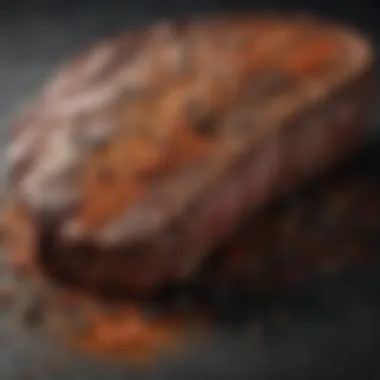
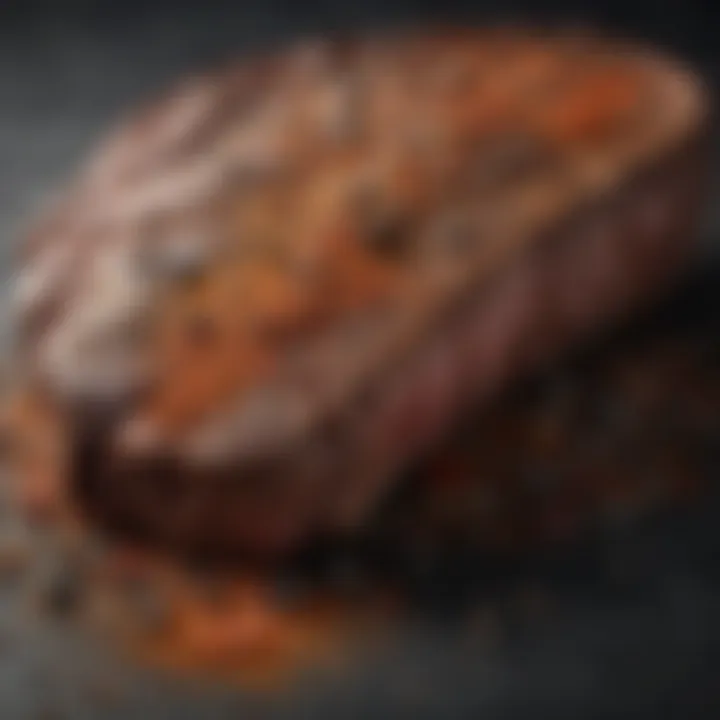
Recipe Highlight
Featured Recipe: Classic Blackened Ribeye
For those passionate about meat, this recipe is a must-try. It perfectly balances bold seasoning with the rich flavor of the ribeye cut. Here are the essentials:
Essential Ingredients:
- Ribeye steak (1-inch thick)
- Blackened steak seasoning
- Olive oil
- Butter
Preparation Time: Approximately 15 minutes
Servings: 2 servings
Step-by-Step Instructions
To achieve that famous blackened crust, careful steps should be followed:
- Preparation: Remove the ribeye steak from the refrigerator and let it rest at room temperature for about 10 minutes. Preheat your skillet or grill to high heat.
- Seasoning: Rub a generous amount of blackened steak seasoning on both sides of the steak. The seasoning should cover the surface well.
- Oiling the Pan: Add a tablespoon of olive oil to the hot skillet and swirl it to coat the bottom evenly. Make sure the smoke starts appearing; this is crucial for the blackened effect.
- Cooking the Steak: Carefully place the steak into the skillet. Sear for about 4 minutes without moving it, allowing it to crust properly. Flip the steak and add a tablespoon of butter to the skillet.
- Finishing: Continue cooking for another 3-4 minutes to reach the desired cook temperature. Use a digital meat thermometer for precision; 130°F is medium-rare.
- Resting: Remove the steak from the carousel of heat and let it rest for 5 minutes. This allows juices to redistribute, enhancing flavor and tenderness.
Insider Advice: Action steps to consider include monitoring the heat closely. If the spice begins to smoke excessively, lower the heat slightly. Common mistakes include flipping the steak too often or not allowing it to sear properly.
Variations and Substitutions
Here are alternative ideas to enhance or cater to your taste:
- Alternative Cuts: Try using filet mignon or sirloin instead of ribeye.
- Lower Sodium Option: Make your own blackened seasoning at home using paprika, cayenne pepper, garlic powder, and other spices without added salt.
- To Add Flair: Drizzle lemon juice or a balsamic reduction over the steak before serving.
For paired sides, consider serving it with sautéed vegetables or a crisp salad.
Time-Saving Cooking Tips
To ensure a smoother experience:
- Prepping Ingredients: Before starting, ensure you have all ingredients measured and ready to go. This avoids chaos while cooking.
- Specific Tools: Use a cast-iron skillet for optimal performance; it retains heat better and promotes even cooking.
- Batch Cooking: If you plan to enjoy blackened steak multiple days, marinate and season more than one piece; they can be cooked later as desired, reducing preparation time.
Nutritional Information
In this recipe, one serving of the Classic Blackened Ribeye has approximately:
- Calories: 500-600, largely depending on cooking fat.
- Key Nutrients: High in protein (approx. 40 gr per serving) and iron.
- Diet Suitability: Generally not vegan or gluten-free; however, with alternatives, this dish can be adapted for specific diets like keto.
By utilizing the information from this guide, you'll master the technique of preparing a delicious blackened steak while adapting it to your taste.
Prelude to Blackened Steak Seasoning
Blackened steak seasoning holds a prominent place in the culinary world, especially among enthusiasts of bold flavors. This popular spice blend enhances the rich taste of cooked meat, contributing a unique depth of flavor. Its significance isn't just about taste; it involves an art form rooted in specific techniques that influence the final result of the dish.
One critical aspect of blackened steak seasoning is its role in defining the identity of blackened cooking. The methodology entails generously applying a mix of spices prior to high-heat cooking, creating a crust is both aromatic and visually appealing. Charring at high temperatures not only develops complex flavors but also seals the juiciness within the meat. As a result, it can elevate a simple steak to a restaurant-quality meal.
Furthermore, preparing blackened steak others offers more than just satisfaction from consumption.** It's suitable for professionals and novice cooks alike. This seasoning allows versatility, as it can adapt to brisket, chicken, pork, and even vegetables. Overall, this section introduces readers to the essential elements of blackened steak seasoning, setting the stage for a deeper exploration of its qualities and applicability. It serves as a launching point to understand the broader implications of blackening in culinary practices.
Historical Context of Blackened Cooking
The historical context of blackened cooking is crucial to understanding its significance in culinary circles today. It goes beyond mere seasoning; it blends tradition, regional influences, and culinary ingenuity, creating a rich tapestry that defines blackened steak. This section will delve into the roots of blackened seasoning and explore how Louisiana's culture has shaped this cooking method.
Origins of Blackened Seasoning
Blackened seasoning originated in Louisiana, diverging from other regional spices by incorporating its complex blend of flavors. The style is credited to chef Paul Prudhomme in the 1980s, who introduced it to a broader audience through his renowned restaurant. However, the idea of blackening steak finds its inspiration in earlier Cajun and Creole cuisines.
The topical application of this seasoning creates a distinct crust while maintaining the juicy tenderness inside, which was initially derived to showcase local fish and other proteins. Over time, the technique evolved and became synonymous with steak, representing an intersection between live cultural culinary practices and a modern flair
Here massive drive play a south-of-the-border factor, with diverse Irish, Spanish, and African influences arriving in the Creole regions. These interactions shaped the palette found in blackened seasoning today. Key spices like paprika, cayenne pepper, oregano, thyme, garlic powder, and more are served as a contrast to showcase the natural flavors of the meat, creating a robust platform for cooks and chefs to experiment.
In fostering the revival of blackened steaks, Prudhomme popularized it through his accessible recipes, emphasizing simplicity yet profound impact.
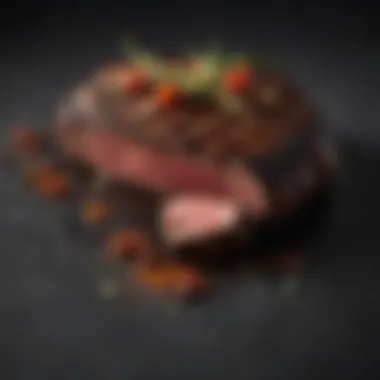
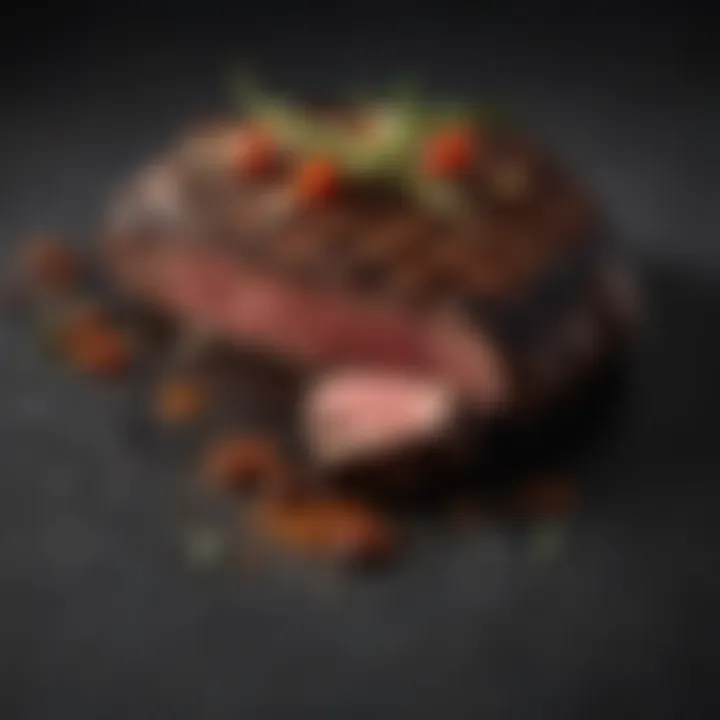
Culinary Influences from Louisiana
Louisiana's cultural heritage plays a fundamental role in the formation of blackened steak seasoning. Known for its unique fusion fueled by various ethnic groups, this region provides an essential context for understanding flavors. Spices found in Cochon de Lait, a traditional roast prepared by the Cajun folks, inspired those who progressively sought robust flavors when preparing steaks.
Moreover, the region attracts palates that beg for creativity, as boredom imposes on various forms of 'normal' meals. Enthusiastic home cooks and professional chefs alike have drawn from these cultural influences to infuse their dishes.
In blackening, diners are not just partaking in a meal; they are consuming a narrative, a robust storm of techniques conquered over generations of cooks. The blackened technique encourages experimentation, allowing individuals to refine their personal tastes, which invigorates an already tantalizing culinary scene.
To sum up, understanding the historical context behind blackened cooking unveils the reasons for its lasting popularity. The marrying of heritage, flavor, and technique will ensure its status in American cuisine maintains.
Understanding the origins of blackened seasoning anchors the meal's historical relevance, enriching the experience the dish brings to the table.
Understanding Blackened Steak Seasoning Ingredients
Understanding the ingredients of blackened steak seasoning is crucial for anyone who wants to master this flavorful method of cooking. Ingredients not only determine the taste but also the aroma and visual appeal of the final dish. Knowing what goes into your seasoning can elevate the overall steak experience and will allow for adjustments based on personal preferences or health considerations.
Key Spices and Their Roles
The blackened steak seasoning primarily relies on a blend of spices that contribute to its signature flavor profile. Each spice serves a unique role:
- Paprika: Adds mild sweetness and a rich red color to the steak.
- Cayenne Pepper: Provides heat, balancing the rich flavor of the meat. Adjust the amount according to preference.
- Garlic Powder: Delivers a deep, savory aroma.
- Oregano and Thyme: These herbs add an earthy quality that complements the other spices well.
- Salt and Black Pepper: Essential for enhancing overall flavor and seasoning the meat properly.
This combination gives the blackened steak its bold characteristics. It's important to find the right balance among these ingredients, as too much heat or seasoning can overshadow the natural flavor of the meat.
Quality of Ingredients: Freshness Matters
The potency of spices diminishes over time, so opting for fresh ingredients is vital. Fresh spices can enhance the depth of flavor significantly.
- Whole Spices vs. Pre-Ground: Where possible, buy whole spices and grind them yourself. Whole spices retain their flavor and aroma, providing a much richer taste.
- Expiration Dates: Regularly check the expiration dates on your spices and replace any that are past their prime.
- Sourcing Quality Ingredients: Seek out local or organic sources when available. Freshly sourced ingredients contribute positively to health and the overall flavor of your dish.
Freshness in spices transforms an average meal into one worth savoring. Just as a well-aged whiskey enhances the drink, so do fresh spices enhance your steak.
By understanding the impact of each ingredient and ensuring their freshness, you are set on the right path to achieving a captivating and flavorful blackened steak. This knowledge is key to not just replicating recipes, but creating personally tailored seasons that reflect your unique tastes.
Preparing Your Own Blackened Steak Seasoning
Preparing your own blackened steak seasoning is both a simple and rewarding process that enhances the quality and flavor of your steak dishes. The act of making your gourmet seasoning allows complete control over the ingredients used, tailoring the flavor profile to suit personal preferences. You also gain the benefit of fresh spices, which can significantly uplift the taste compared to pre-packaged alternatives.
Homemade seasoning introduces versatility into your cooking routine. The flavor combination you create can be maintained for various meats or even vegetables, allowing for a cohesive and rich taste throughout your meals. Additionally, preparing your own blend often paves the way for healthier alternatives, as commercial products might contain artificial preservatives or excessive sodium.
Considerations regarding your space, pantry and time management are important aspects for preparation too. It is an ideal way to incorporate leftover spices you already have.
Essential Tools and Equipment
The right tools and equipment are essential when prepping your homemade blackened steak seasoning. Gathering the following tools will simplify the process:
- Measuring spoons: Precision is critical when balancing the spices, ensuring you get the proper amount to create the optimal blend.
- Mixing bowl: A medium-sized bowl is perfect for combining your ingredients effectively.
- Whisk or fork: A simple instrument here can greatly help to evenly distribute and blend all the spices together.
- Airtight container: Post-preparation, using containers keeps the seasoning fresh, allowing easy access each time you want to enhance the flavor of your meal.
It's easy to gather these items, and you might find you already have many of them in your kitchen. This represents an investment of effort into maximizing your culinary endeavors.
Step-by-Step Recipe for Homemade Seasoning
Creating your own blackened steak seasoning is a straightforward process. Follow these steps to craft your personalized blend:
- Gather the Ingredients: The typical staples in blackening seasoning include:
- Measuring and Combining: Using the measuring spoons, explore the balance of the key spices. A foundational ratio could include: 2 tablespoons paprika, 1 teaspoon cayenne, 1 teaspoon each of onion powder, garlic powder, thyme and oregano, salt, and pepper to taste. Adjust these measurements as per your liking.
- Mixing Well: In your mixing bowl, use a whisk or fork to combine all the ingredients thoroughly. Ensure the mixture is uniform in texture and color.
- Taste Testing: It's a good idea to taste a small pinch to make sure the seasoning is balanced to your preference. You can always modify it.
- Storing Your Seasoning: Place your blended seasoning into an airtight container. It can last for an extended time if stored in a cool dark place. Check periodically for freshness, and measure doses as needed.
- Paprika (preferably smoked for extra richness)
- Cayenne pepper (for heat)
- Onion powder
- Garlic powder
- Dried thyme and oregano
- Salt and black pepper
- Optional: brown sugar for a hint of sweetness
With each batch that you create, consider this a personal imprint on your cooking. Not only does this educate you on seasoning herbs, but it also enriches your dedication to elevate flavors at home.
Making your own blackened seasoning results in a unique culinary expression that fits your taste palate perfectly.
Techniques for Blackening Steak


Understanding the correct techniques for blackening steak is essential for achieving the ideal flavor and texture. Blackening steak is more than just seasoning; it involves specific cooking methods that intensify the taste while achieving the characteristic char. Each step contributes differently to the final outcome. The cooking technique can significantly influence the moisture retention of the meat, uniform cooking, and the development of crust. Mastery of these techniques is especially valuable for avoids overcooking or burning, which can ruin a perfectly good cut of steak.
Selecting the Right Cut of Steak
Choosing the right cut of steak is vital for blackening. The flavor and texture can vary widely among different cuts. Some favorites include:
- Ribeye: Known for its marbling and tenderness, it offers robust flavors that work well with caramelization from blackening.
- Striploin: A good balance of lean meat and marbling, the striploin is versatile with its flavor.
- Filet Mignon: This cut is tender and has a subtle beef flavor, though it may not hold up as well under intense heat, which can limit its use in blackening.
- Flank or Skirt Steak: More economical but potent in taste, these cuts benefit from the intense seasoning and cooking methods.
Selecting a cut should be based on personal taste preferences and cooking style. Quality is just as crucial. A fresher cut often means better taste and cooking experience.
Prepping Your Steak for Seasoning
Prepping the steak properly is just as crucial as selecting the right cut. Here are key steps to follow:
- Thawing: If frozen, allow the steak to thaw completely in the refrigerator. This aids in even cooking.
- Pat Dry: Use paper towels to pat the steak dry. Excess moisture can hinder the formation of a nice crust during cooking.
- Trim Excess Fat: While some fat can add flavor, too much can flare up and burn during the cooking process. Trim excess fat but leave some for richness.
- Scoring: Lightly score the fat on the edge if necessary; this helps fat render out in cooking.
- Pre-season Lightly: Optionally sprinkle a bit of salt about 30 minutes before applying the blackened seasoning. This can enhance the overall flavor during cooking.
- Coat Evenly with Seasoning: Apply blackened steak seasoning generously but not excessively. Spread it evenly on all sides of the steak.
Following careful prep steps allows the marinated flavors to penitrate deeper into the meat while ensuring the perfect blackened exterior during cooking.
Executing these techniques with precision will ensure that the steak is not just blackened but takes on the unique character of this delicious southern cooking style.
Cooking Methods for Blackened Steak
Cooking methods significantly influence the final taste and texture of blackened steak. Different chefs have unique preferences and techniques to achieve this. The two prime methods include grilling and pan-searing, which both offer distinct advantages. Understanding how these methods work can enhance the flavors and achieve that desired charred exterior, which is a hallmark of blackened steak.
Grilling: Achieving the Perfect Char
Grilling is an outdoor cooking method that involves cooking meat over direct heat. This method provides strong, direct heat that allows the steak to develop a deep, smoky flavor while creating a lovely crust. When grilling blackened steak, consider the following:
- Temperature Control: Setting the grill to a high temperature is essential to create the perfect char. A hotter surface leads to improved caramelization.
- Preparation of the Grill: Make sure the grill grates are thoroughly cleaned and oiled. This prevents sticking and allows the seasoning to enhance the meat instead of burning off.
- Done-ness: It is valuable to monitor steak temperature with a meat thermometer. This enables better control over how well-done the meat is.
Tips for Grilling Blackened Steak:
- Preheat the grill to about 450°F to 500°F.
- Timing is crucial; a good rule is to grill for roughly 3-5 minutes per side depending on thickness.
- Let the steak rest for a few minutes covered with foil after grilling.
“Getting the right intense heat and timing will create that much-desired blackened crust.”
Pan-Searing: A Quick Approach
Pan-searing is favored for its simplicity and speed. Cooking steak in a heavy skillet or cast iron pan on a high flame helps develop deep flavor quickly without the need for elaborate setups. Here are some elements to consider while pan-searing:
- Choosing the Right Pan: A cast-iron skillet retains heat better and distributes it evenly, which is favorable for creating that blackened finish.
- Use Minimal Fat: Too much fat can interfere with the charr, so a light coating of cooking oil is usually enough.
- Construction: Ensure to let the pan get very hot before adding the steak to achieve optimal searing results.
Steps for Pan-Searing Blackened Steak:
- Heat the skillet to medium-high until it is almost smoking.
- Place the steak in the pan without crowding it, adjusting to full heat if needed.
- After searing, flip to achieve a nicely crusted surface, which generally takes around 4-6 minutes per side.
These methods allow for flexibility, each one aligning with different contexts and desire. Selecting one will customize the revised technique for preparing blackened steak, achieving concentrations of flavor that translate into rich, enjoyable meals.
Serving Suggestions for Blackened Steak
Serving suggestions are critical when it comes to pairing with blackened steak. This section aims to elevate the dining experience of the main dish through complementary flavors, textures, and aromas. Understanding what to serve alongside blackened steak not only enhances its appeal but also reveals a deeper culinary appreciation. Thus, the dishes and beverages selected should reflect care in preparation and thoughtfulness in balance to avoid overwhelming the palate.
Complementary Side Dishes
Choosing side dishes for blackened steak involves considering contrasting flavors and textures. You want sides that complement the spice and richness without overcrowding the dish. Here are some thoughtful suggestions:
- Roasted Vegetables: Carrots, asparagus, and bell peppers add color and a slight sweetness that pairs well with the robust nature of the steak.
- Garlic Mashed Potatoes: Creamy potatoes can soothe the palate. Adding roasted garlic can bring out additional layers that blend nicely with the seasonings of the steak.
- Coleslaw: This offers a refreshing crunch. A simple vinegar-based slaw can cleanse the palate between bites of rich blackened steak.
- Grilled Corn on the Cob: The natural sweetness of corn contrasts well with spices and can be geared up or down based on seasoning level.
These options can create a more rounded plate, allowing the blackened steak to shine while ensuring a satisfying meal. Attention to not only flavors but textures and visual presentation can transform a simple meal into a culinary event.
Wine Pairing with Blackened Steak
Wine pairing remains an art and science. Choosing the right wine with blackened steak makes a difference. The complexity and bold flavors of the steak call for robust wines. Here are some suggestions to consider:
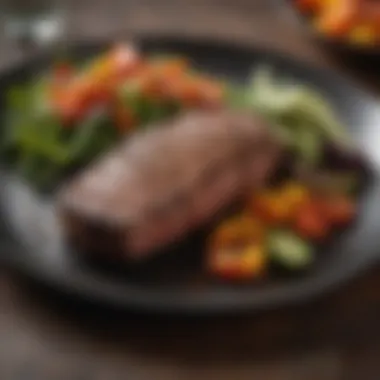
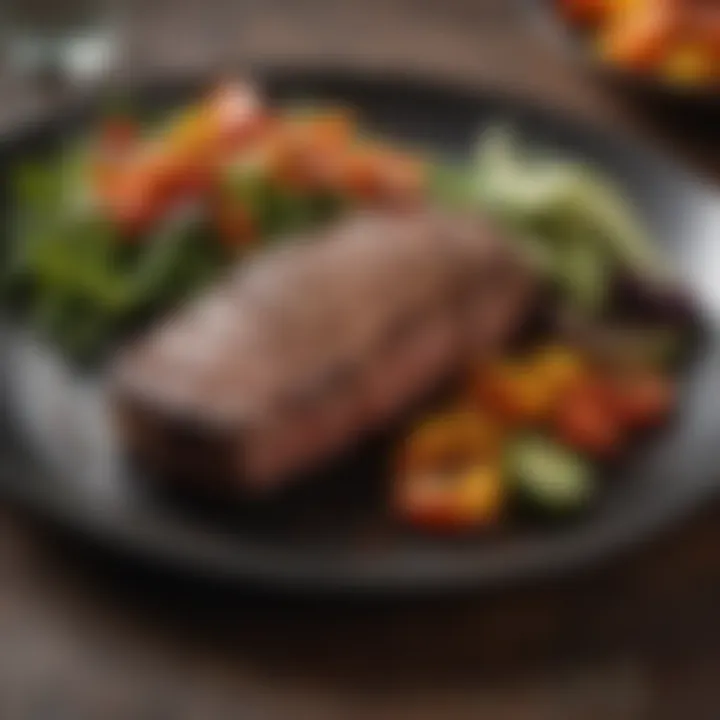
- Zinfandel: With its unceasing fruitiness and peppery notes, Zinfandel complements the spices well, creating a cohesive taste profile.
- Syrah/Shiraz: The bold character of this wine, with dark fruit notes and a bit of spiciness, interacts positively with the flavors in the seasoning, heightening the overall experience.
- Cabernet Sauvignon: A classic choice, its full-bodied nature and strong tannins balance well against a heavily seasoned steak, complementing the dish's intense flavors.
- Malbec: Often paired with grilled meats, Malbec’s soft tannins and fruit flavors create an intuitive pairing with the strong spices typical of blackened seasonings.
Key Considerations for Wine Pairing
- Match the wine intensity with the seasoning intensity.
- Focus on tannins and acidity to ensure the wine does not overpower the dish.
- A thoughtful pairing uplifts both the meal and dining experience significantly.
Always remember: The aim of pairing is to elevate the experience, not remove it. Selected wines must work well with the spices without overpowering the blackened steak itself.
In summary, serving suggestions can truly enhance blackened steak, offering an opportunity to present flavors harmoniously. Careful pairing with sides and wines allows the strong flavors of the steak to resonate beautifully, promoting awareness and enjoyment of each bite.
Common Mistakes to Avoid When Blackening Steak
Understanding the common pitfalls in blackening steak is essential for elevating your cooking to a higher level. The blackening technique overly relies on timing and spice balance, both of which are critical to the final flavor and texture of the dish. Recognizing mistakes like over-seasoning and underestimating cooking times can make the difference between an impressive steak and a disappointing meal. It's not simply about making a steak look good; it's about achieving a dish that is delightful in taste and appearance.
Over-seasoning and Its Effects
One major error that home cooks often encounter is over-seasoning. Blackened steak seasoning is potent by nature, composed of spices like paprika, cayenne, garlic powder, and others that can easily overpower the meat. In an effort to pack in flavor, cooks may apply a heavy hand with the spices. However, this counterproductive approach can lead to an overwhelming taste that masks the quality of the steak itself.
The primary consequence of over-seasoning is the loss of natural flavors. Instead of enhancing the steak, the spices can create a harsh, unauthentic experience. A greasy texture can also develop from excess seasoning. Towards that end, it is wise to sprinkle the seasoning gradually and taste as you go. This approach ensures a balance is maintained, keeping the steak enjoyable while delighting your palate with the intended zesty punch of seasonings. Moreover, too much salt can draw out moisture from your steak, which may lead to a dry final product.
Underestimating Cooking Times
Another frequent miscalculation lies in underestimating cooking times. The aim of blackening is to attain a charred outer crust while ensuring the meat remains juicy inside. Inadequate cooking can lead to underdone steak, where the center is not cooked to your preferred level. This mistake promotes food safety concerns, as a raw center can harbor bacteria, particularly in larger cuts of beef.
To avoid this, investors need to monitor heat consistently and understand their cooking methods. Whether grilling or pan-searing, both have distinct characteristics influencing heat distrubution.
For instance, when utilizing cast iron pans, a distinct heating pattern can fluctuate between spots, causing uneven cooking. Utilizing a food thermometer is an optimal technique; it enables close monitoring of the internal temperature of the steak. Typically, a medium-rare steak should be cooked to an internal temperature of 130-135°F (54-57°C). Taking the time to appreciate these nuances will richly enhance the final dish.
The wrong timing or excessive spice application can ruin a good steak. Aim for precision and balance.
Understanding and actively avoiding these common mistakes will undoubtedly move your steak from average to exceptional. By sensing the right amount of seasoning and accounting for cooking times, you'll cultivate a truly memorable dining experience.
Health Considerations Related to Blackened Steak
Blackened steak is not just a culinary delight but also brings certain health considerations that should be acknowledged. Understanding these factors assists in balancing enjoyment and well-being. Various elements play a crucial role in assessing the health aspects of consuming blackened steak, such as its nutritional value and the balance of meals. Being informed can enhance your cooking and dining experience without sacrificing health.
Understanding the Nutritional Value
When looking at the nutritional profile of blackened steak, it essentially depends on the cut of meat and additional ingredients used in seasoning. Generally, steak is a significant source of:
- Protein: Essential for muscle repair and growth. A single serving can offer a substantial amount of daily protein needs.
- Vitamins: Blackened steak provides B vitamins, particularly B12, which is vital for nerve function and the production of DNA.
- Minerals: Good source of iron, zinc, and selenium, all important for overall health and metabolic functions.
While indulging in blackened steak, it's crucial to check portion sizes. The preparation method also affects nutritional content. For example, avoiding excessive butter or oils retains more health benefits and reduces calorie intake. Lean cuts like sirloin or tenderloin might be better for those cautions of fat consumption.
Culinary choices can have a favorable impact on nutritional balance. Selecting lean cuts prepared with vigor and attention ensures steak can fit into a health-conscious meal plan.
Moderation and Cooking Frequency
Moderation is key. It's tempting to incorporate blackened steak into weekly meals but doing so frequently may lead to overconsumption of red meat. Recommendations from nutrition experts suggest limiting intake to a couple of times a month. Consider also the impact of consuming high sodium content from seasoning.
To balance out your diet:
- Vary proteins: Include cuts of chicken, turkey, or fish to create a more diverse meal plan.
- Integrate vegetables: Pairing steak with a variety of vegetables provides fiber and nutrients that can promote digestive health when included in meals.
- Mind your seasoning: Experimenting with herbs can reduce dependence on salt. Fresh herbs offer flavor without raising sodium levels.
Cooking steak less often can make each preparation an event, cherished for its unique flavor and excitement. This not only heightens anticipation but also builds a minimalistic approach encouraging variety, improving overall dietary balance. Notice how these steps serve well for both culinary satisfaction and health enhancement.
Culmination: The Allure of Blackened Steak
The fascination with blackened steak boils down to a rich tapestry of flavors and techniques it presents. This culinary practice, blending unique spices and high-heat cooking methods, captures a distinct essence that appeals to food enthusiasts. The prominence of blackened steak is evident not only in its bold taste but also in the way it transforms ordinary cuts of meat into extraordinary dishes.
Key Elements of Blackened Steak
- Intriguing Flavor Profile: The depth of taste derived from the seasonings creates a bold and complex flavor that marries well with the natural savory qualities of beef.
- Visual Appeal: Its signature char crust gives blackened steak an attractive appearance, enhancing both presentation and perceived taste.
- Culinary Versatility: Blackened seasoning can be applied beyond steak, influencing many dishes, from seafood to vegetables.
“Blackened steak embodies culinary artistry in its simplest form—sourced ingredients expertly combined through craftsmanship.”
Blackened steak is not just about edibility, but the experience surrounding its preparation and presentation. This article reveals the contextual history, ingredient selection, and cooking methods that distinctly define blackened steak.
Understanding the nutritional value and health considerations is also crucial. Awareness of portion sizes is vital for those balancing savor with healthy eating.
In essence, blackened steak offers much more than surface-level satisfaction. It's about a cooking philosophy rooted in boldness and balance. The allure lies in its ability to bring people together, enhancing shared meals and encouraging culinary exploration. Whether you are a novice tackling the basics or a seasoned cook looking to refine techniques, the art of blackened steak remains a timeless journey worth participating in.







